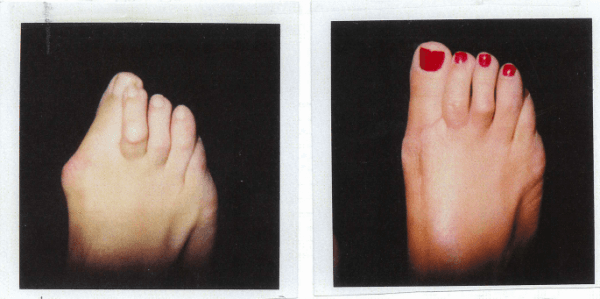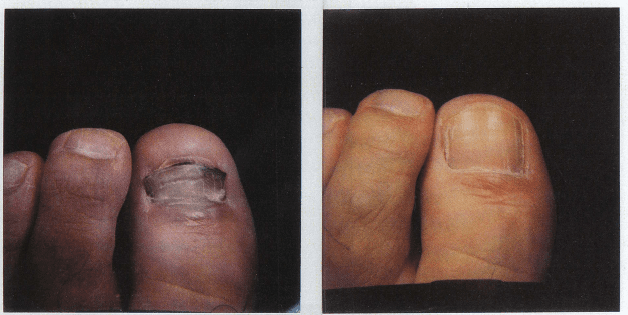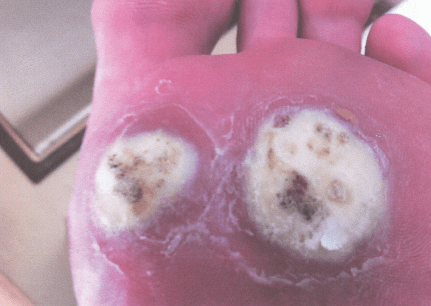NEW YORK—Do you know the Pareto principle? The one that says 80 percent of effects come from 20 percent of the causes? The principle applies to foot problems as well. Each foot has 26 bones, 33 joints, and more than 100 connective tissues. There’s so much that can go wrong.
But heel pain, pinched nerves, bunions, ingrown nails, hammertoes, and infections are so common that 80 percent of all people will have one of these problems at some point in their lives, according to Dr. Steven P. Abramow of Manhattan Podiatry Associates in Midtown.
He and Dr. John E. Mancuso began Manhattan Podiatry Associates, P.C. in 1981. Now they have four locations in Midtown East, Upper East Side, Financial District, and Bryant Park.
The doctors at Manhattan Podiatry Associates give a detailed explanation of the most commonly seen foot problems.
Heel Pain
The plantar fascia is the major ligament that supports the bottom of the foot and attaches to the bottom of the heel bone. If you feel pain in your heel or if the bottom of your foot hurts when you stand or walk, it is probably the plantar fascia causing the pain.
Causes: Heel pain is most commonly the result of too much stress on the heel bone and soft tissues that attach to it. This stress can be cumulative, caused by impact and shoes that don’t properly support the foot.
Treatment: Treatment for heel pain focuses on relieving tension on the heel and reducing inflammation. A laddered approach starts with changing your shoes, stretching, physical therapy, orthotics, cortisone treatments, anti-inflammatory medications, and rest.
If these conservative methods don’t work, you can get an MRI to check for a tear in the plantar fascia or heel bone swelling.
Until recently, surgery would have been recommended in these cases, however, for the past 10 years, Manhattan Podiatry has been using a non-surgical therapy called Extracorporeal Shock Wave Therapy (ESWT) for patients who did not respond to conservative treatments. ESWT uses high-intensity sound waves to heal the injured plantar fascia.
In our practice, this innovative treatment has reduced the need for invasive surgical treatments by approximately 90 percent. Heel pain tends to be chronic, so treatment should be started as soon as possible.
—Dr. John E. Mancuso, doctor of Podiatric Medicine and Surgery
Neuroma
A neuroma is a benign growth of nerve tissue frequently found between the third and fourth toes or the second and third toes.
It usually manifests as a sharp pain with burning, tingling, or numbness in the toes or balls of the feet when walking in shoes. When a person stops walking, takes off their shoe and rubs their foot, the symptoms typically go away.
Causes: Neuromas are usually caused by genetic bone structure and mechanical imbalance, causing the nerve to get irritated.
Treatment: Neuromas can often be treated by modifying your shoes and activities, using orthotics, padding, anti-inflammatory medication, and with injection therapy.
We have had excellent success in eliminating symptoms with a series of alcohol injections which shrink and desensitize the neuroma.
Neuromas can be easily removed surgically with a 15-minute office procedure that has a short recovery time.
—Dr. Steven P. Abramow, doctor of Podiatric Medicine and Surgery
Bunions

Bunions are a common condition which manifest as a bump or projection of bone and soft tissue at the base of the big toe and cause the foot to get wider.
Causes: Bunions are a hereditary condition that get larger and more symptomatic with time. While shoes do not cause the bunion to develop, they can aggravate them causing redness, inflammation, and pain.
A bunion is actually not a growth of bone but a displacement of metatarsal bones that cause the big toe to lean towards the second toe. As a bunion gets larger, it can become arthritic, causing stiffness and loss of mobility in the joint.
Treatment: We begin by modifying your shoes and activities, and using orthotics, anti-inflammatory medication, padding, and physical therapy.
If these fail, you might consider surgery. The purpose of surgery is to remove the bony protrusion and most importantly, to restore the normal alignment of the joint so that it can function properly.
In our practice, innovative techniques allow surgery to be performed in an office or an outpatient center. The patient can walk immediately afterwards with minimal pain. Most patients can return to work within four days and be back in loose-fitting shoes in three weeks.
As with many problems, it’s best to treat the bunions early on. The less severe the problem, the better the result.
—Dr. Steven P. Abramow, doctor of Podiatric Medicine and Surgery
Fungal Nail Infection

Podiatrists deal with fungal nail infections on a daily basis.
The fungus causes painful thickening and discoloration. If left untreated, it can cause a secondary bacterial infection of the surrounding soft tissue structures.
Causes: Infections are caused by a naturally present microorganism called a dermatophyte. These organisms can enter the nail if you either walk in a damp environment, or get a pedicure with improperly sterilized instruments.
After exposure, it is possible for the fungus to be visibly undetectable and not cause any discomfort. Certain diseases like diabetes, circulatory problems, or people who have compromised immune conditions may influence whether or not a fungal infection worsens.
Treatment: Treatment consists primarily of a combination of oral anti-fungal medications, topical therapy, and non-painful laser treatments.
At Manhattan Podiatry Associates, we utilize the Cutera Genesis Xeo, a totally painless and state-of-the-art laser that uses a specific wavelength to destroy the fungus while leaving normal skin or nail unaffected. This laser has no side effects and can penetrate the nail’s matrix to allow new, fungal-free growth.
—Dr. Mark J. Landsman, doctor of Podiatric Medicine
Ingrown Nail
An ingrown nail occurs when one or both sides of a nail begin to grow into the skin of the toe. This can cause pain, redness, warmth, drainage, and infection of the surrounding skin and soft tissue.
Causes: Improperly cutting a nail and shoe pressure can cause an ingrown nail. An ingrown nail can be acute or chronic, and may be associated with an underlying medical condition, such as diabetes and psoriasis, as well as bone spurs, trauma, or occupational causes.
You might not notice acute paronychia caused by an infection until the offending nail border starts to grow into the skin, causing pain, redness, and swelling. As this happens, the nail plate or cuticle might loosen and allow the infection to worsen.
Treatment: We remove the offending border of the nail to allow the adjacent skin to heal. This can be done with or without anesthesia, depending on how bad it is, and of course, patient tolerance.
For recurring or chronic ingrown nails, we do a minor surgical procedure under local anesthesia. A small border of the side of the nail is removed and either a chemical or laser is used to destroy the portion of the growth center where the ingrown nail originates.
This procedure is called a matrixectomy and can take little as 15 minutes in our office. Patients usually return to work immediately afterwards with little discomfort.
—Dr. Mark J. Landsman, doctor of Podiatric Medicine
Warts

Warts are a common, sometimes painful skin condition that is caused by a virus. The virus, which prefers a warm, moist environment, needs only a micro-opening to embed itself into your skin.
Causes: Walking barefoot in your gym’s locker room or pool will increase your exposure to developing warts. Since there are numerous skin conditions that resemble and are mistaken for warts, benign and malignant, it is best to immediately seek the help of a podiatrist for a quick and accurate diagnosis.
Treatment: Treatments may range from topical medications such as salicylic acid to the latest in high-tech lasers like the Yag laser. Lasers such as the CO2 laser can cauterize the wart and is performed using local anesthesia in your podiatrist’s office.
As always, an ounce of prevention is the best medicine, so avoid walking barefoot, keep your feet clean and dry, avoid contact with warts from other people, and periodically check your feet.
—Dr. Howard Shapiro, doctor of Podiatric Medicine and Surgery
Hammertoe
A hammertoe is due to the shortening and hardening of a toe joint.
When a hammertoe develops, a high point is created on top of the knuckle of the toe exposing it to direct shoe pressure. This leads to pain and inflammation, formation of corns, pain in the ball of the foot and even infection. When it becomes difficult to wear shoes comfortably and interferes with your daily comfort it is time to visit a podiatrist.
Causes: Hammertoe is caused by muscular imbalances, trauma, heredity reasons, or arthritis. Ill-fitting footwear can exacerbate this condition. Hammertoes are more commonly seen in women than men. This deviation can be flexible or a more serious rigid type where the toe loses flexibility.
Treatment: A podiatrist will determine the cause of your condition by examining your foot and taking an x-ray. Conservative treatments include paddings, anti-inflammatory drugs to ease the pain, and shaving of corns and calluses.
Custom-made shoe inserts help correct the muscular imbalances.
Surgical intervention is also available and commonly performed by your podiatrist. There are several different types of surgical procedures available to help you with your problem.
With today’s innovative and minimally invasive techniques, hammertoes can usually be surgically corrected in the office on a Friday with return to work on Monday.
—Dr. Howard Shapiro, doctor of Podiatric Medicine and Surgery






Friends Read Free